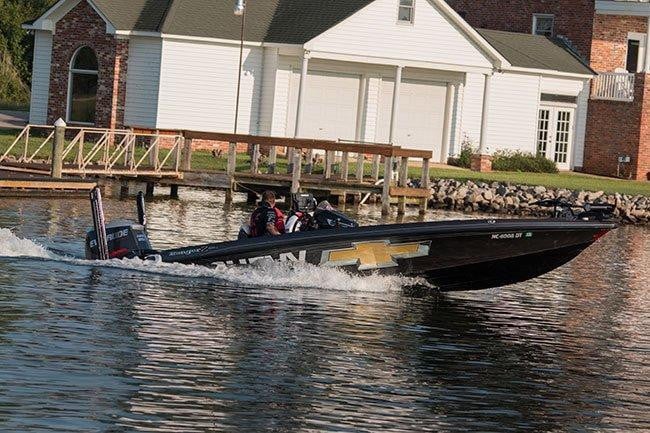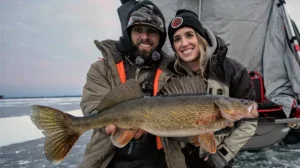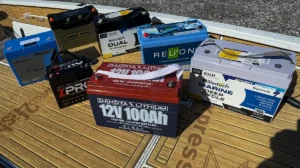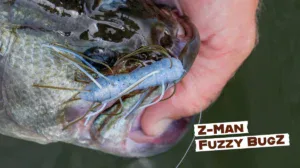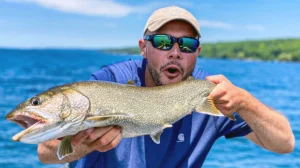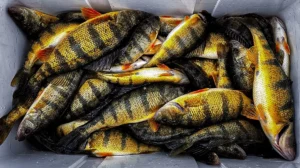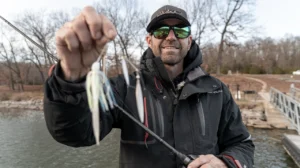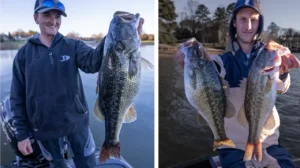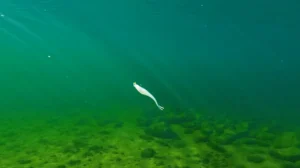Some folks view boat docks as recreational platforms used for swimming, grilling and enjoying cold beverages on hot summer days. Bass anglers, however, are of a much different breed. When we look at a dock, suntan lotion and lounge chairs are the last things on our minds—we see a golden opportunity for giant fish catches.
According to FLW Tour pro and dock fishing extraordinaire Bryan Thrift, fishing topwater lures underneath dock walkways is an incredible method for catching big, suspended late-summer bass.
While other anglers methodically pitch and flip these manmade structures, he looks to target the most aggressive fish while covering water at astonishing speeds.
It’s all about the bluegill
Don’t let the hordes of bass boats floating above offshore structure throw you for a loop. While you can probably catch a few deep water bass right now, Thrift believes there are two entirely different populations of bass from which to choose.
“Dock walkways play host to huge populations of bluegill and offer bass unlimited ambush points, resulting in a perfect storm for incredible topwater action.”
“I really enjoy fishing this time of year because you have two options,” Thrift said. “You can target deep water bass as they chase nomadic schools of bait or in this case, you can fish for the more reliable shallow bass feeding on bream and crawfish. Dock walkways play host to huge populations of bluegill and offer bass unlimited ambush points, resulting in a perfect storm for incredible topwater action.”
If a healthy population of bluegill is present, why not fish the entire dock? His pinpoint method revolves around two very important concepts—perceived safety and efficiency.
“It’s not science, but I feel like the bluegill feel a bit safer in the shallow water underneath these walkways,” Thrift said. “It also seems like the walkways play host to the smaller yearling bream, which are practically filet mignons to a big bass. By just focusing on these areas, I can cover water much faster as fast as opposed to picking apart the entire dock.”
Adopt a sense of urgency
As the sun gets higher throughout the day, summer bass fishing can get pretty darn tough. For this very reason, Thrift has a major sense of urgency when dissecting walkways with topwater lures.
“I try to fish as many walkways as I possibly can early in the morning,” Thrift said. “You have a very limited window to get that big bite and the first two or three hours of daylight are absolutely crucial. This is when you have to put the puzzle together very quickly because the bite will be slow after 10 o’clock in the morning. So you have to develop confidence in your pattern before it turns into a grind.”
In the 2014 Forrest Wood Cup on Lake Murray, Thrift caught the bigger limits of bass he weighed by mid-morning. I photographed him one of these mornings and he was moving faster than any angler I’ve ever seen—and that’s no exaggeration.
“If my trolling motor batteries aren’t dead by the end of the day, I feel like I didn’t fish efficiently,” Thrift said. “You have to fish every type of dock until you start getting bites. That’s the only way to develop a sustainable pattern.”
Essential characteristics to look for
Because efficiency is such an integral ingredient to his late-summer walkway pattern, Thrift has become an expert at spotting high-percentage docks at a glance. In order for him to spend time fishing a particular walkway, it needs to have one of the following four characteristics.
- Deeper water on the first poles—”I want the first poles—the ones closest to the bank—to have at least three or four feet of water on them,” Thrift said. “These steeper banks create more of a shade line later in the day and give both the bass and bluegill an added sense of security.”
- Isolated shade—”When it gets to be lunchtime, I’m looking for shaded walkways,” Thrift said. “I’ll fish ’em every single time. Bass can’t put on a good pair of sunglasses when it’s hot and sunny, so any isolated shade from nearby trees is likely to concentrate bass.”
- Brush piles—”Looking for dock-mounted rod holders is an excellent way to locate brush piles quickly,” Thrift said. “I’m not necessarily fishing the brush, but the bass that live in it will likely feed under the shallow walkways early in the morning, making them prime targets for a well-placed topwater lure.”
- Sand—”This is kind of rare deal, but if you find them relating to walkways on sandy beach areas, you can absolutely hammer the bass,” Thrift said. “You might only get on this pattern a few times each summer, but it’s always worth checking.”
Topwater selection and follow-up baits
“Dock fishing is at its toughest in the late-summer,” Thrift said. “But that’s not because the bass aren’t biting—they’re usually just suspended. When you pitch and flip these docks, you’ll catch a few, but you’re going to be working that jig or worm beneath them and it’s difficult to make a bass swim downward to your bait. When you use topwaters, however, the bass are in a great position to annihilate it.”
“You want to see the bass staring at the dock posts like they’re in timeout. When they position themselves like this, it’s game over.”
While water color doesn’t necessarily play a role in Thrift’s decision whether or not to fish walkways with topwaters, it does influence his lure selection.
- Clear water—”In clear water, it’s not uncommon to see the bass before you even make a cast,” Thrift said. “This is when I want a more subtle lure—one that’s not too noisy. Stealth is your friend in this situation so you’ll have more success on natural colors and profiles. I do a lot of damage with a Damiki D Pop 70 and a Damiki Air Frog.”
- Dirty water—”It’s hard to make precise casts in dirty water because you can’t see how the bass are positioned,” Thrift said. “Louder baits will attract fish in the surrounding area, so I tend to use a Damiki MTB Noisy Buzzbait and a prop bait more in these conditions.”
Although topwaters serve as his primary weapon, there are two times when Thrift opts for a different approach—if he hasn’t had any bites by 10 o’clock in the morning or if the bass are short-striking his offerings.
- Jig—”If I can’t get anything going by mid-morning, I’ll start alternating casts with a topwater and a jig,” Thrift said. “I’ll flip a brown or green jig under the walkway, hop it a few times and swim it back to the boat while pumping my rod tip. This is a great way to fool bass when they won’t quite commit to topwater presentations.”
- Wacky worm—”If I’m seeing bass and they won’t eat my topwater, I’ll skip a wacky rig to ’em,” Thrift said. “I use a 4-inch Damiki Stinger on 15-pound P-Line TCB Braided Line with a 8-pound P-Line Ultimate Fluorocarbon leader and it works like a charm. It falls much slower than many stick worms, giving the bass plenty of time to react to it.”
Make your first cast count
When bass are relating to shallow walkways, it doesn’t take long to trick them into biting. A single bad cast, however, can quickly make them uncatchable.
“If you’re going to get bit, it’s going to happen on the first cast almost every time,” Thrift said. “This makes good casting skills essential. If you start ringing the dinner bell on pontoon boats, they know you’re there. And once they feel like something’s not right, they’re 100 percent more difficult to catch.”
To maintain a stealthy approach, Thrift makes an effort to land his topwater lure on the opposite side of the walkway. Landing in the middle—or “juice”—of the walkway creates too much surface disturbance for these already wary bass.
“Everyone makes a bad cast every now and then,” Thrift said. “But there’s a way to recover from it. If you alert the bass to your presence, try flipping a light shaky head or drop shot rig underneath the walkway. Both of these rigs land very quietly and are very unimposing to the bass. It’s a great way to fool some of the big wolf packs that are known to roam under walkways.”
If you’re looking for a quick way to develop a strong and predictable late-summer bass fishing pattern, spend some time skipping your favorite topwater lures under walkways. Not only will you be around big bass—you’ll likely have ’em all to yourself.
Fishing dock walkways with topwater lures was a key pattern for Thrift in the 2014 Forrest Wood Cup on Lake Murray.

